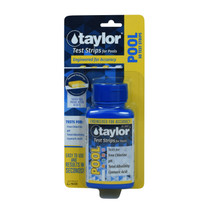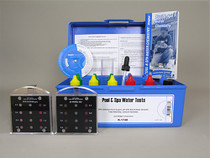
Taylor Technologies Inc
Taylor FAS-DPD/CYA/pH Chlorine (Hi-Range) 2000 Series Pool Inspector Kit
- SKU:
- K-2009
- UPC:
- 840036004531
- Availability:
- in stock
Description of Tests
| Analyte | System | Method/Chemistry | Standard/Equivalance or Description | Comparator | Cell |
|---|---|---|---|---|---|
| Chlorine, Free & Combined | Drop test | FAS-DPD | 1 drop = 0.2 or 0.5 ppm chlorine (Cl?) | 9058 | NA |
| Cyanuric Acid | Visual determination | Turbidimetric | 30, 40, 50, 60, 70, 80, 90, 100 ppm CYA | 9058 | NA |
| pH | 2000 Series comparator | Phenol red | 7.0, 7.2, 7.4, 7.6, 7.8, 8.0 | 9058 | NA |
Potential Interferences
| Test Parameter | Description |
|---|---|
| Chlorine | Chlorine levels > approx. 25 ppm may bleach out indicator or cause sample to develop a brown color; to prevent, add more DPD powder or dilute sample with DI water as necessary and retest. Other halogens and oxidized manganese may cause positive interference. |
| pH | Iron > 10 ppm may cause negative interference. |
| pH | Sanitizer levels > approx. 10 ppm may cause a blue-purple color resulting in false high readings. Wait for sanitizer level to decrease to normal levels and retest to assure an accurate reading. |
Shelf Life Concerns
REAGENT SHELF LIFE
All reagents have a shelf life, whether they are liquids, powders, crystals, tablets, or test-strip pads. If kept dry, powders and crystals are very stable; acids are also long lived. Date of manufacture is not the controlling factor when it comes to shelf life—storage conditions are more important. As with all perishables, reagents are sensitive to environmental influences and will last longer under controlled conditions.
To this end, we recommend:
- Storing reagents at a consistent temperature in the range if 36°–85°F (2°–29°C); extreme temperature fluctuation, say from a refrigerator to a hot car trunk, causes reagents to deteriorate.
- Keeping them out of prolonged direct sunlight. (Note: their brown plastic bottles help protect very light-sensitive reagents.)
- Segregating reagents from containers of treatment chemicals.
- Replacing caps immediately and tightening them carefully so that exposure to air and humidity is limited.
- Avoiding switching bottle caps, placing bottle caps on soiled surfaces, repouring reagents into contaminated containers, or touching test strip pads.
Taylor formulates its reagents to remain effective for at least one year, with only very few exceptions (molybdenum indicator in liquid form is one; after four months old it should be tested against a standard periodically). As a general precaution, replace all reagents more than one year old, or at the beginning of a new testing season.
Returns Policy
You may return most new, unopened items within 30 days of delivery for a full refund. We'll also pay the return shipping costs if the return is a result of our error (you received an incorrect or defective item, etc.).
You should expect to receive your refund within four weeks of giving your package to the return shipper, however, in many cases you will receive a refund more quickly. This time period includes the transit time for us to receive your return from the shipper (5 to 10 business days), the time it takes us to process your return once we receive it (3 to 5 business days), and the time it takes your bank to process our refund request (5 to 10 business days).
If you need to return an item, simply login to your account, view the order using the "Complete Orders" link under the My Account menu and click the Return Item(s) button. We'll notify you via e-mail of your refund once we've received and processed the returned item.
Shipping
We can ship to virtually any address in the world. Note that there are restrictions on some products, and some products cannot be shipped to international destinations.
When you place an order, we will estimate shipping and delivery dates for you based on the availability of your items and the shipping options you choose. Depending on the shipping provider you choose, shipping date estimates may appear on the shipping quotes page.
Please also note that the shipping rates for many items we sell are weight-based. The weight of any such item can be found on its detail page. To reflect the policies of the shipping companies we use, all weights will be rounded up to the next full pound.





 5138
5138 












